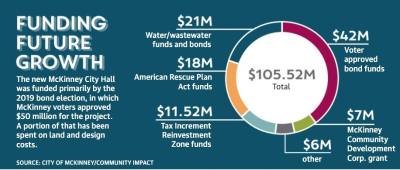City officials held a groundbreaking ceremony for the new city hall Oct. 24 and anticipate an October 2024 completion date.
“What we [chose] over here on the east side was very deliberate. We saw an opportunity to use this development as a catalyst project, spurring economic development and opportunity on the east side,” McKinney Mayor George Fuller said at the groundbreaking.
The new city hall is primarily funded by a $50 million bond passed by voters in 2019. The call for the bond election was preceded by a 2018 study that informed the departmental, hiring and workspace needs the new facility would serve, Assistant City Manager Barry Shelton said.
However, the plan to build a new city hall has been on the books since 2006, Shelton said. Between 2010-20, McKinney has grown 49% and this year surpassed 200,000 residents, according to census data.
In 2019 the city manager’s office knew the project would total at least $85 million, Shelton said. That cost has increased with time. A construction contract amendment was approved Oct. 18 and set a guaranteed maximum price of nearly $104 million for the total cost of the project.
“[The bond committee] figured we would have other sources of funding that could fill the gap, so they went for the $50 million to the voters knowing it was going to take more than $50 million to construct,” Shelton said.
The site for the new space sits only a half mile from the building being used for city hall, and it is adjacent to other east McKinney redevelopment projects, such as the upcoming Tupps Brewery site, the newly painted silos and street improvement projects.
McKinney-based Pogue Construction Company has begun construction. Work will include improvements to nearby roadways.
“Construction is messy, and we’re gonna see a couple years of streets being torn up and railroad crossings being reconstructed and things like that, but in the end, we think the benefits are going to be tremendous,” Shelton said.The community-oriented city hall building is expected to reach the finish line in October 2024, two years after the groundbreaking.
A community gathering space
The process for determining the facility’s design began with the hiring of architectural firms Lake Flato and Parkhill, Shelton said.
Scott Nelson, the director of community for Parkhill, said the firm worked with city staff to create guiding principles that informed the decision-making process throughout the project.
“Collaboration and communication are key to any project’s success and even more so for a project of this magnitude,” Nelson said.
Design plans for the complex include community-oriented amenities, which include an outdoor plaza that can be used to host events and gatherings.
Nelson described the plaza as a key element of the design, citing its potential as an “inviting community space.” The city will coordinate curating events and activities in the plaza as well as finding ways to bring the community together there.
“Our objective for the programming was always to really connect with the neighborhoods of this particular part of the community and kind of see what works for them,” Assistant City Manager Kim Flom said.
Another community-oriented section is the dog run, a tunnel-style pass with a rotating educational historic exhibit along the walls. The 100-foot pathway will have a dedicated yearly budget that will be used to collaborate with local organizations to create McKinney-focused history exhibits.
“It will honor those communities that made up the east side and describe our history and honor our history in a very informative way for people that visit,” Fuller said.
Shelton said the architects spent time analyzing Historic Downtown McKinney to assess how elements, such as brick color and other facade features, could be incorporated into the new building while maintaining a modern look inspired by buildings like the Pearl Brewery in San Antonio and the Austin Central Library in Austin.
The interior and exterior design elements reflect the site’s historical “agribusiness” uses, Shelton said. The design of the building also includes glass wall elements for the council chambers, acting as a “physical manifestation of [the] transparency that we operate by,” Shelton said.
Central government services
The new city hall will be 175,000 square feet spread out over five floors and provide office space for various city departments. This will bring city staff from nine different offices under one roof, Shelton said. It will also eliminate the $650,000 the city pays annually in rent costs for buildings in use.
“Our departments are spread out over 7 miles across the city. Bringing all of our departments under one roof comes with an inherent synergy and efficiency,” Fuller said.
Some of the existing offices—such as human resources and code enforcement—are leased by the city and will be returned to the owners. The buildings owned by the city, including the existing city hall and development services, will either be sold intact or demolished before selling the land, Shelton said. The city wants the developments and businesses that will eventually take their place to enhance downtown, Shelton said. The city has used the current building as its city hall since 1988, officials said.
For city staff, the new building will bring together employees who have never worked under the same roof, Shelton said. The building is designed to accommodate growth by intentionally creating open spaces and limiting hard walls, according to Shelton.
“We wanted that space to be something with a lot of flexibility, because our staffing numbers and what we need the building to be today are most likely going to be very different than what we’re going to need in 20 years,” Shelton said.
For the community, this means city services will be centralized and more easily accessible, Shelton said. The first floor will include the council chambers, a utility billing service counter and a community event space with direct access to the outdoor plaza.
“It becomes more than just an office space for city employees. It becomes a true community building,” Shelton said.
The long-term vision
The new city hall will be nestled on 9 acres between various other east side redevelopment projects, including the Flour Mill and Tupps Brewery.
Tupps will relocate from its site on Anderson Street into a remodeled grain mill with a 25,000-square-foot, four-story brewery. In addition to a brewery, the project will also feature a retail craft community shopping area on-site, a full-service restaurant, a coffee shop, indoor and outdoor stages, fire pits, and more across 4 acres.
“Part of our value add in moving to the east side is we’re going to bring the fun and the culture and a social environment,” Tupps Brewery President Keith Lewis said. “That will help really stimulate a lot of other growth to happen on the east side, and eventually, it will be the place to go.”
The new city hall will be just one street over from the new Tupps site. The two projects will complement each other and help call attention to the east side of the city, Lewis said.
“For the longest time there just wasn’t commercialization on the east side, and it was almost a forgotten zone,” Lewis said. “And there’s so much history; there’s so much culture. It’s just a really neat part of town.”Fuller said redevelopment of the east side was part of his mayoral election campaign. Despite the push for growth, Fuller recognized the potential for negative repercussions on nearby residential communities.
“We are sensitive to the fact that the negative aspect of development like this in the older neighborhood is generally gentrification, which comes with potentially pricing [people] out. That’s been something we’ve been acutely aware of and cognizant of ... [so] we’re developing programs that will protect homeowners that are there now,” Fuller said.
The site for the new city hall has been unoccupied for a number of years, with a single industrial building on the site. No residential homes have been displaced by this project.
Shelton said, once city hall is completed, the city expects further interest in redevelopment of nearby historic buildings, particularly along Virginia Street and Louisiana Street. Shelton also noted that the 500 publicly usable parking spots the city hall complex will provide will give parking relief to existing and future nearby venues.
“This [City Hall] is going to carry us forward long after we’re gone and the city grows to a much larger community,” City Manager Paul Grimes said.
Additional reporting by Miranda Jaimes.







